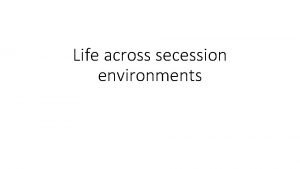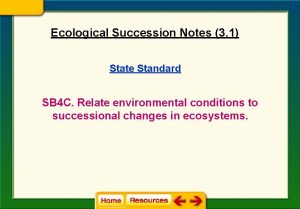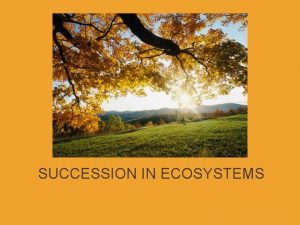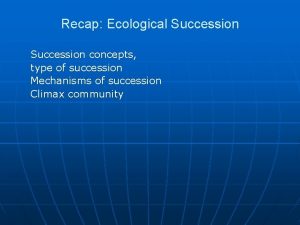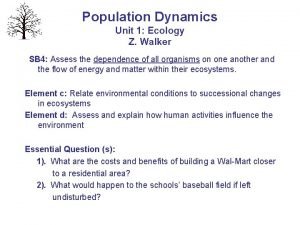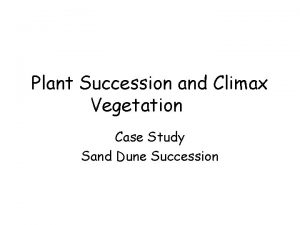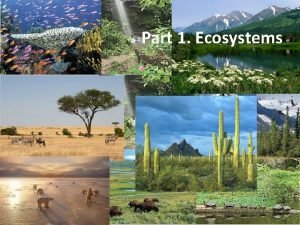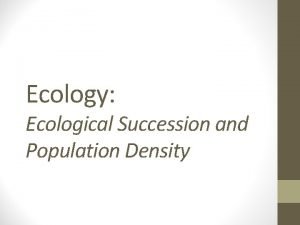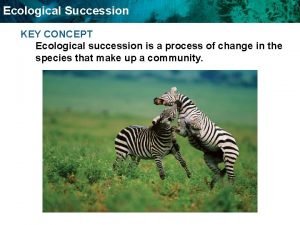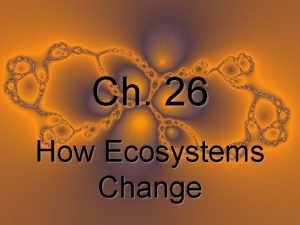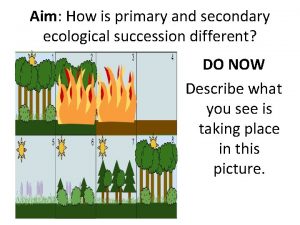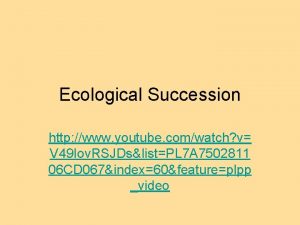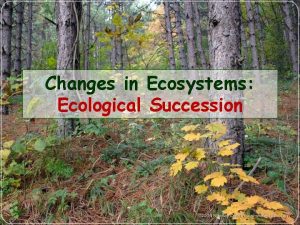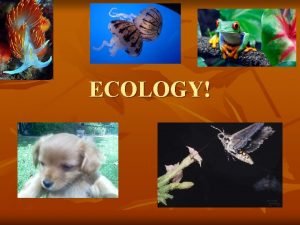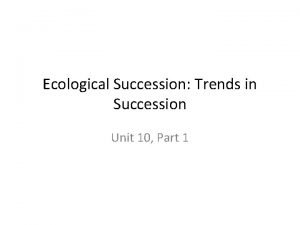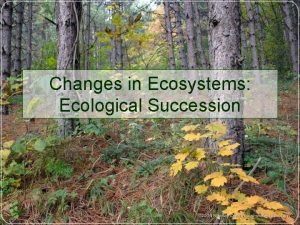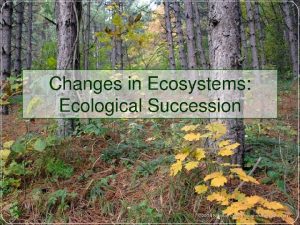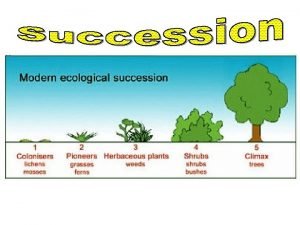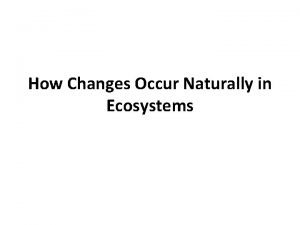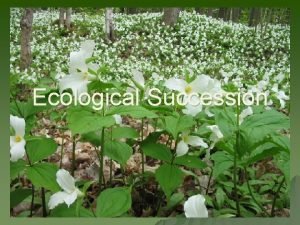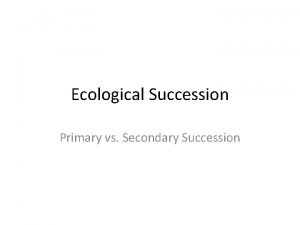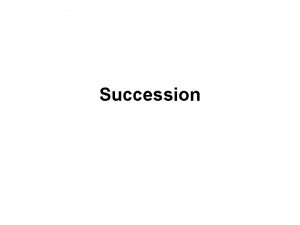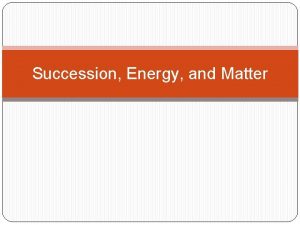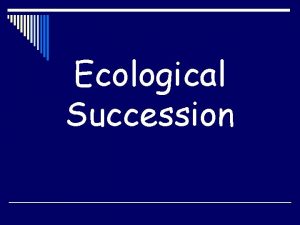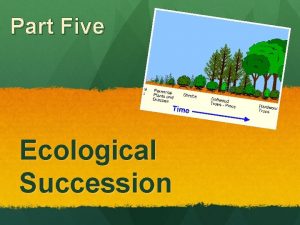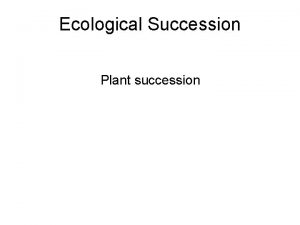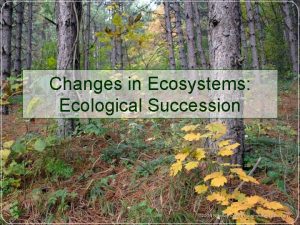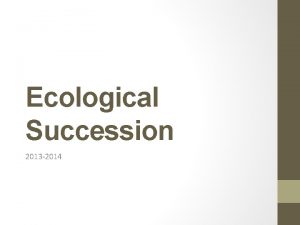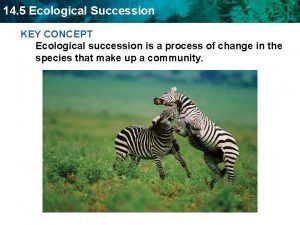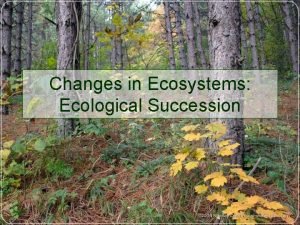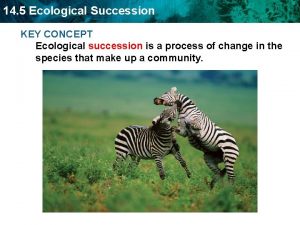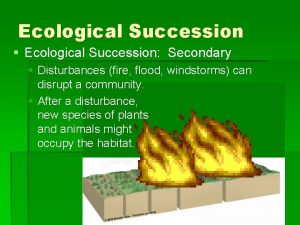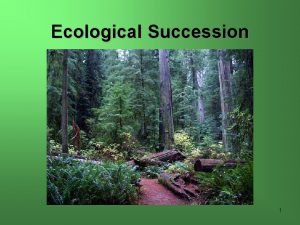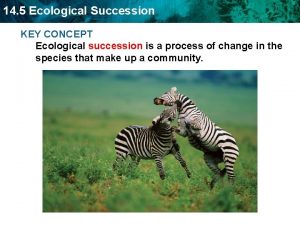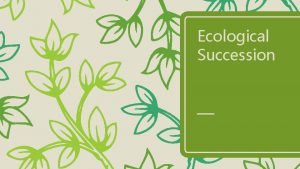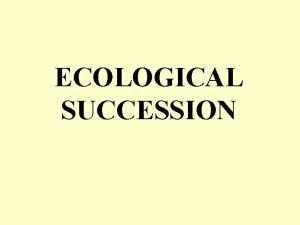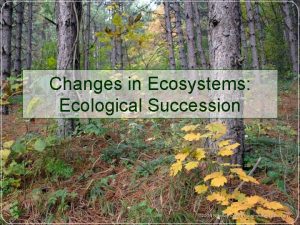Ecological Succession Trends in Succession Unit 10 Part






















- Slides: 22

Ecological Succession: Trends in Succession Unit 10, Part 1

Section 1: Ecological Succession • Although you probably haven’t thought about it, the shrubs, moss or grasses you see when walking along a sidewalk could be the beginnings of new, natural communities. • If these areas were not altered by human activities, each would undergo a series of changes in which different species of organisms would appear, to be replaced later by others. • Given enough time, each area would become a complex and stable community.

Succession and its Causes • The series of changes in a community is called ecological succession. • The diversity of organisms living in each community today is not the same as it was in the past. Biotic and abiotic factors have changed over time. • Some communities may be stable, having undergone changes over a long period of time, and others may not yet be stable and still have some changing to do.

What Causes Ecological Succession? • A major factor is the effect a particular set of organisms has on the physical environment. • During succession, organisms alter their physical surroundings in a way that makes those surroundings more suitable for other kinds of organisms and less suitable for themselves. As a result, new organisms invade and the old organisms move out.

Primary Succession • Succession that begins in areas where there is no life is called primary succession. • This stage begins with very tough organisms those that can grow under adverse conditions. • This is called the pioneer stage.

Climax Community • The stable stage in the development of a community is known as the climax community. • The type of climax community that emerges in a given area depends on the interaction of all factors in the environment. • Because it is stable and complex, a climax community tends to remain the same over a long period of time without further succession.

Secondary Succession • Succession often begins as a result of natural destruction, such as fire, volcano, or flooding, or by human interference. • In either case, new succession begins when the dominant plants of a community are removed. • If the land is left untended, secondary succession occurs. • This happens more quickly than primary succession because soil is already formed and seeds may be present.

Succession of Plants

Trends in Succession • Whether primary or secondary succession, both have common characteristics. • At the beginning, small plants with short life cycles (such as grass) are present. These are later replaced with larger plants with longer life cycles (like trees). This traps more energy via photosynthesis, which increases the biodiversity over time. • Food chains are short and simple at first, but increase in complexity as time goes on and more species are present. • Recycling of wastes and nutrients also becomes more efficient.

Ecological Succession: Human Interaction Unit 10, Part 2

Human Interaction • Humans have obviously done a lot to change the ecosystems in which they live. • Picture the journey across America. Some places are dense with people, building, and cars, while others seem untouched. Other places have been heavily traveled, while still more have only been walked by cattle, buffaloes, and deer. • While we love the modern marvels we use daily, what is the price of all these changes we’ve made?

Pollution and Pesticides • Imagining that cross-country trip again, describe the difference between the air in California and the air in Iowa. • How does the population density of humans affect this? • What are some things we do to contribute to the pollution? • What can we change to make it better? • These are all questions we must ask in order to determine the solutions to the decline of our resources.

Pollution • Pollution is caused by many factors, almost all of which can be attributed to human activity. • The burning of fossil fuels (e. g. , gasoline and coal) to power our cars, the use of substances containing CFCs (chlorofluorocarbons), and the dumping of wastes into our water are all sources of pollution.

The Problem With Pesticides • Pesticides, while beneficial for farmers protecting their crops, also have a downside. • First, they’re toxic chemicals. Releasing them into the air, the soil, and the water, exposes not only humans, but also countless other organisms to their dangers. • Secondly, after awhile, most insects will develop a resistance to them, forcing us to create newer, better, and more harmful toxins. • Is this ever a good thing?

Are There Other Options? • There are some non-chemical, natural alternatives to using pesticides. • One would be to release natural predators to keep pest populations in check. • Another would be to use the pests’ own biochemical characteristics against them. • Other alternatives, called cultural controls, involve breeding plants that are resistant to pests, or that have their own defense mechanisms.

The Consequences • In recent years, more attention has been paid to the relationship between the population boom and the damage being done to our atmosphere. • Space issues, resource availability, disease, and intraspecific competition are all factors that affect the human population.

The Ozone Layer: A Hole in the Sky • As you’ve probably heard, there is a hole in what we call the ozone layer. Ozone is a chemical (O 3 to be exact) that serves many purposes: to protect the Earth from space debris, to help control the temperature, and perhaps most importantly, to shield the earth from harmful ultraviolet radiation from the sun. • So, what’s the problem with the deterioration of the ozone layer?

Acid Precipitation • As we know, the abundance of factories and automobiles burning fossil fuels can wreak havoc on the atmosphere. • One such problem with this is the acid (mostly sulfuric acid) that builds up when smoke gets trapped in the air. • When it rains, snows, sleets, or hails, the water collects the acid and brings it down with it. This results in the deterioration of metals, the increased acidity of the soil, and a p. H change of water sources.

Global Warming • Global warming and the ‘greenhouse effect’ are both issues as the average temperature of the earth increases. • The greenhouse effect occurs when gases are trapped in the atmosphere. These gases are heated by the sun, which makes our temperatures on earth even higher. • How might this affect different plants and animals?

Conservation of Resources • You’re probably familiar with the symbol below, which means ‘reduce, reuse, recycle. ’ • What are some ways we do this now? • What are some ways we can do this in the future?

Food, Fuels, and Forests • We can increase food by practicing selective breeding to produce more grain per plant. We can also replace the plants we have cut down in another area. • We can seek out alternative fuel sources, such as ethanol, nuclear energy and solar power to reduce the burning of fossil fuels. • We can recycle paper products to keep from having to cut down more trees and destroying forests and the animals who live in them. • Any other ideas?

Is There Any Hope? • Pollution, over-consumption, and an expanding human population are real and important problems facing the earth. • With enough planning and cooperation, we can reverse some of the damage that’s been done over time and ensure that there’s a place for our grand-children to live. • Scientists have been working on alternative energy sources, and more people are recycling. Together, these things should add years to the life of Earth.
 Ecological succession succession of a pond
Ecological succession succession of a pond Ecological succession succession of a pond
Ecological succession succession of a pond Ecological succession def
Ecological succession def Jessica gurevitch
Jessica gurevitch Venn diagram of primary and secondary succession
Venn diagram of primary and secondary succession Ecological succession case study
Ecological succession case study Ecological succession
Ecological succession Energy naturally flows from warmer matter to cooler matter
Energy naturally flows from warmer matter to cooler matter Ecological disturbance
Ecological disturbance Types of succession
Types of succession Type of succession
Type of succession Tundra seasons
Tundra seasons Homework ecological succession answer key
Homework ecological succession answer key Youtube ecological succession
Youtube ecological succession Def of secondary succession
Def of secondary succession Primary succession comic strip
Primary succession comic strip What causes primary succession
What causes primary succession Examples of secondary succession
Examples of secondary succession Primary succession examples
Primary succession examples Primary ecological succession
Primary ecological succession Ecological succession
Ecological succession Ecological succession
Ecological succession Climax in ecological succession
Climax in ecological succession
